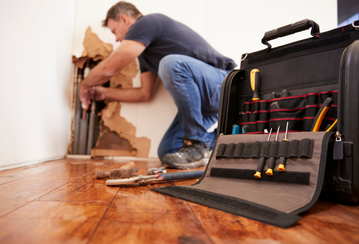News and Updates
How to protect yourself from restoration fraud
No homeowner ever wants to find damage to their home following an extreme weather event or other disaster. In these situations, it is important to quickly find a reputable contractor to help you clean up and restore your home so you can get back to where you started. Unfortunately, there are fraudsters ready to take advantage of these circumstances. That’s why the Insurance Bureau of Canada warns homeowners to watch out for restoration fraud when hiring a vendor to repair their homes.
What is restoration fraud?
Restoration fraud is a type of contractor fraud. It involves a contractor or vendor scamming a homeowner after being hired to perform restoration work — typically following a natural disaster or other emergency. In these cases, the homeowner often needs immediate assistance and wants to get their house back to normal as soon as possible, making it easy for a fraudster to take advantage of the situation. These dishonest individuals may overcharge for their services, use substandard materials, or perform shoddy work.
If insurance is paying to repair the damage to your home as part of a claim, a vendor may overbill for the job, assuming your insurance company will pay the total amount. However, there are limits to what insurance will pay for certain items. That’s why it’s important to recognize the signs of restoration fraud, so you never end up paying out of pocket for fraudulent charges.
Warning signs to look out for
Being on the lookout for fraud is one of the best actions you can take to support fraud prevention. Here are some common warning signs of restoration fraud to watch out for:
-
High-pressure sales tactics. The contractor is being pushy and trying to rush you through the process, emphasizing the situation’s urgency.
-
Demand for full payment upfront. The contractor refuses to start work without the total value of the quote being paid upfront.
-
No written contract. The contractor wants to work out a verbal agreement or cash deal without a contract, typically with the false promise that this will keep costs lower for you.
-
Missing licensing, insurance or permits. The contractor can’t produce proof of licensing or Workers’ Compensation coverage. Necessary building permits aren’t issued or posted for significant construction projects, which can cause problems for you down the line.
-
Work beyond the original quote. The contractor suggests or starts working on unrelated or extra work that was not included in the initial agreement.
-
Unexpected “problems” driving up the cost. Unforeseen complications can be legitimate, but some fraudsters will make up non-existent “problems” and pressure you to agree to the extra work.
Fraud prevention tips
Here are some steps you can take to protect yourself from becoming a victim of restoration fraud:
-
Know your rights. As a consumer, you have rights under your province’s Consumer Protection Act. For example, some provinces have limitations on how much a final price can exceed the agreed contract price. Review your provincial Consumer Protection Act to understand your rights and what protections are available to you.
-
Get it in writing. Ask for a written contract from your vendor and review it closely before work begins. Make sure your contract includes:
-
The full name of the contractor you’re working with, as well as any subcontractors. Ask for government-issued ID to verify their identity.
-
Detailed scope of work that matches or is very close to the original estimate.
-
The vendor’s GST/HST and business license number. You can verify GST and HST numbers on Revenue Canada’s website and confirm they are registered with the Better Business Bureau.
-
Payment schedule with a reasonable upfront deposit and a ‘hold back’ payment that you will pay only after you’ve inspected and are satisfied with the work done.
-
-
Ask for proof of Workers’ Compensation insurance. A professional contractor should have Workers' Compensation insurance, which provides them coverage for medical treatment and salary protection in the case of a work-related injury or occupational disease.
-
Check references. Ask for and contact references provided by your vendor to ask about their past work.
-
Never agree to cash payments. A cash payment or underground deal can put you at risk. All payments should be trackable and listed in the agreed-upon payment schedule in your contract. If you do pay in cash, always get a receipt.
-
Document the process. Take pictures and videos before, during and after the repairs are finished. Ensure the work done matches the work agreed to in your contract.
-
Do your research. Fraudsters will try to take advantage of an assumed lack of knowledge about the repairs being done to your home. Take control of the situation by educating yourself on the project’s key steps to keep vendors accountable.
What to do if you think you’ve been the victim of restoration fraud
We all need to do our part to help fight fraud. According to the Insurance Bureau of Canada (IBC), fraud costs Canadians more than $1 billion every year. In fact, IBC estimates that at least 15% of your insurance payments end up covering fraudulent claims.
If you think you’ve been the victim of restoration fraud, report it. Contact your insurer right away to report the fraud and fill them in on the details of the situation.
In addition to contacting your insurer, you can also:
-
Anonymously report suspected fraud to IBC through their confidential online form or by calling 1-877-IBC-TIPS (1-877-422-8477).
-
Contact the Canadian Anti-Fraud Centre at 1-888-495-8501 or info@antifraudcentre.ca.
Having adequate home insurance coverage can give you peace of mind following a disaster. If you have questions about your current insurance coverage, contact your OTIP broker at 1-833-494-0089. If you’re shopping for home insurance and would like to get a quote, connect with an OTIP broker today at 1-833-615-9326.
Related articles: Learn how to protect benefits fraud – and protect your plan, Helping to prevent benefits fraud, Fighting Fraud, and Don’t get “wheeled” into a staged car accident.





